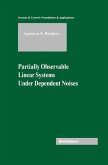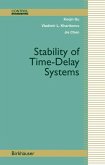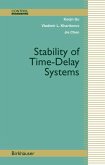- Gebundenes Buch
- Merkliste
- Auf die Merkliste
- Bewerten Bewerten
- Teilen
- Produkt teilen
- Produkterinnerung
- Produkterinnerung
This book is the result of our teaching over the years an undergraduate course on Linear Optimal Systems to applied mathematicians and a first-year graduate course on Linear Systems to engineers. The contents of the book bear the strong influence of the great advances in the field and of its enormous literature. However, we made no attempt to have a complete coverage. Our motivation was to write a book on linear systems that covers finite dimensional linear systems, always keeping in mind the main purpose of engineering and applied science, which is to analyze, design, and improve the…mehr
Andere Kunden interessierten sich auch für
![Linear System Theory Linear System Theory]() Frank M. CallierLinear System Theory115,99 €
Frank M. CallierLinear System Theory115,99 €![Mathematical Models in Electrical Circuits: Theory and Applications Mathematical Models in Electrical Circuits: Theory and Applications]() C. A. MarinovMathematical Models in Electrical Circuits: Theory and Applications53,99 €
C. A. MarinovMathematical Models in Electrical Circuits: Theory and Applications53,99 €![Stochastic Theory and Control Stochastic Theory and Control]() Bozenna Pasik-Duncan (ed.)Stochastic Theory and Control115,99 €
Bozenna Pasik-Duncan (ed.)Stochastic Theory and Control115,99 €![Nonlinear Control in the Year 2000 Nonlinear Control in the Year 2000]() Alberto Isidori / Francoise Lamnabhi-Lagarrigue / Witold Respondek (eds.)Nonlinear Control in the Year 2000153,99 €
Alberto Isidori / Francoise Lamnabhi-Lagarrigue / Witold Respondek (eds.)Nonlinear Control in the Year 2000153,99 €![Partially Observable Linear Systems Under Dependent Noises Partially Observable Linear Systems Under Dependent Noises]() Agamirza E. BashirovPartially Observable Linear Systems Under Dependent Noises77,99 €
Agamirza E. BashirovPartially Observable Linear Systems Under Dependent Noises77,99 €![Stability of Time-Delay Systems Stability of Time-Delay Systems]() Keqin GuStability of Time-Delay Systems84,99 €
Keqin GuStability of Time-Delay Systems84,99 €![Stability of Time-Delay Systems Stability of Time-Delay Systems]() Jie ChenStability of Time-Delay Systems77,99 €
Jie ChenStability of Time-Delay Systems77,99 €-
-
-
This book is the result of our teaching over the years an undergraduate course on Linear Optimal Systems to applied mathematicians and a first-year graduate course on Linear Systems to engineers. The contents of the book bear the strong influence of the great advances in the field and of its enormous literature. However, we made no attempt to have a complete coverage. Our motivation was to write a book on linear systems that covers finite dimensional linear systems, always keeping in mind the main purpose of engineering and applied science, which is to analyze, design, and improve the performance of phy sical systems. Hence we discuss the effect of small nonlinearities, and of perturbations of feedback. It is our on the data; we face robustness issues and discuss the properties hope that the book will be a useful reference for a first-year graduate student. We assume that a typical reader with an engineering background will have gone through the conventional undergraduate single-input single-output linear systems course; an elementary course in control is not indispensable but may be useful for motivation. For readers from a mathematical curriculum we require only familiarity with techniques of linear algebra and of ordinary differential equations.
Produktdetails
- Produktdetails
- Verlag: Springer New York / Springer US, New York, N.Y.
- 1991
- Seitenzahl: 532
- Erscheinungstermin: 3. September 1991
- Englisch
- Abmessung: 241mm x 160mm x 34mm
- Gewicht: 957g
- ISBN-13: 9780387975733
- ISBN-10: 038797573X
- Artikelnr.: 22044796
- Herstellerkennzeichnung
- Springer-Verlag GmbH
- Tiergartenstr. 17
- 69121 Heidelberg
- ProductSafety@springernature.com
- Verlag: Springer New York / Springer US, New York, N.Y.
- 1991
- Seitenzahl: 532
- Erscheinungstermin: 3. September 1991
- Englisch
- Abmessung: 241mm x 160mm x 34mm
- Gewicht: 957g
- ISBN-13: 9780387975733
- ISBN-10: 038797573X
- Artikelnr.: 22044796
- Herstellerkennzeichnung
- Springer-Verlag GmbH
- Tiergartenstr. 17
- 69121 Heidelberg
- ProductSafety@springernature.com
1 Introduction.- 1.1 Science and Engineering.- 1.2 Physical Systems, Models, and Representations.- 1.3 Robustness.- 2 The System RepresentationR(
) = [A(
),B(
),C(
),D(
)].- 2.1 Fundamental Properties ofR(
).- 2.2 Applications.- 2d The Discrete-Time System RepresentationRd(
) = [A(
),B(
),C(
),D(
)].- 2d.1 Fundamental Properties ofRd(
).- 2d.2 Application: Periodically Varying Recursion Equations.- 3 The System RepresentationR= [A,B,C,D], Part I.- 3.1 Preliminaries.- 3.2 General Properties ofR= [A,B,C,D].- 3.3 Properties of R when A has a Basis of Eigenvectors.- 3d The Discrete-Time System Representation Rd = [A,B,C,D].- 3d.1 Preliminaries.- 3d.2 General Properties of Rd.- 3d.3 Properties of Rd when A has a Basis of Eigenvectors.- 4 The System Representation R = [A,B,C,D], Part II.- 4.1 Preliminaries.- 4.2 Minimal Polynomial.- 4.3 Decomposition Theorem.- 4.4 The Decomposition of a Linear Map.- 4.5 Jordan Form.- 4.6 Function of a Matrix.- 4.7 Spectral Mapping Theorem.- 4.8 The Linear Map X ? AX+XB.- 5 General System Concepts.- 5.1 Dynamical Systems.- 5.2 Time-Invariant Dynamical Systems.- 5.3 Linear Dynamical Systems.- 5.4 Equivalence.- 6 Sampled Data Systems.- 6.1 Relation BetweenL- and z-Transforms.- 6.2 D/A Converter.- 6.3 A/D Converter.- 6.4 Sampled-Data System.- 6.5 Example.- 7 Stability.- 7.1 I/O Stability.- 7.2 State Related Stability Concepts and Applications.- 7d Stability: The Discrete-Time Case.- 7d.1 I/O Stability.- 7d.2 State Related Stability Concepts.- 8 Controllability and Observability.- 8.1 Controllability and Observability of Dynamical Systems.- 8.2 Controllability of the Pair (A(
),B(
)).- 8.3 Observability of the Pair (C(
),A(
)).- 8.4 Duality.- 8.5 Linear Time-Invariant Systems.- 8.6 Kalman Decomposition Theorem.-8.7 Hidden Modes, Stabilizability, and Detectability.- 8.8 Balanced Representations.- 8.9 Robustness of Controllability.- 8d Controllability and Observability: The Discrete-Time Case.- 8d.1 Controllability and Observability of Dynamical Systems.- 8d.2 Reachability and Controllability of the Pair (A(
),B(
)).- 8d.3 Observability of the Pair (C(
),A(
)).- 8d.4 Duality.- 8d.5 Linear Time-Invariant Systems.- 8d.6 Kalman Decomposition Theorem.- 8d.7 Stabilizability and Detectability.- 9 Realization Theory.- 9.1 Minimal Realizations.- 9.2 Controllable Canonical Form.- 10 Linear State Feedback and Estimation.- 10.1 Linear State Feedback.- 10.2 Linear Output Injection and State Estimation.- 10.3 State Feedback of the Estimated State.- 10.4 Infinite Horizon Linear Quadratic Optimization.- 10d.4 Infinite Horizon Linear Quadratic Optimization. The Discrete-Time Case.- 11 Unity Feedback Systems.- 11.1 The Feedback System ?c.- 11.2 Nyquist Criterion.- 11.3 Robustness.- 11.4 Kharitonov's Theorem.- 11.5 Robust Stability Under Structured Perturbations.- 11.6 Stability Under Arbitrary Additive Plant Perturbations.- 11.7 Transmission Zeros.- Appendix A Linear Maps and Matrix Analysis.- A.1 Preliminary Notions.- A.2 Rings and Fields.- A.3 Linear Spaces.- A4. Linear Maps.- AS. Matrix Representation.- A.5.1 The Concept of Matrix Representation.- A.5.2 Matrix Representation and Change of Basis.- A.5.3 Range and Null Space: Rank and Nullity.- A.5.4 Echelon Forms of a Matrix.- A.6 Notmed Linear Spaces.- A.6.1 Norms.- A.6.2 Convergence.- A.6.3 Equivalent Norms.- A.6.4 The Lebesgue Spaces 1P and LP [Tay.1].- A.6.5 Continuous Linear Transformations.- A.7 The Adjoint of a Linear Map.- A.7.1 Inner Products.- A.7.2 Adjoints of Continuous Linear Maps.- A.7.3 Properties of the Adjoint.-A.7.4 The Finite Rank Operator Fundamental Lemma.- A.7.5 Singular Value Decomposition (SVD).- Appendix B Differential Equations.- BA Existence and Uniqueness of Solutions.- B.1.1 Assumptions.- B.1.2 Fundamental Theorem.- B.1.3 Construction of a Solution by Iteration.- B.1.4 The Bellman-Gronwall Inequality.- B.1.5 Uniqueness.- B.2 Initial Conditions and Parameter Perturbations.- B.3 Geometric Interpretation and Numerical Calculations.- Appendix C Laplace Transforms.- C.1 Definition of the Laplace Transform.- C.2 Properties of Laplace Transforms.- Appendix D the z-Transform.- D.1 Definition of the z-Transform.- D.2 Properties of the z-Transform.- References.- Abbreviations.- Mathematical Symbols.
) = [A(
),B(
),C(
),D(
)].- 2.1 Fundamental Properties ofR(
).- 2.2 Applications.- 2d The Discrete-Time System RepresentationRd(
) = [A(
),B(
),C(
),D(
)].- 2d.1 Fundamental Properties ofRd(
).- 2d.2 Application: Periodically Varying Recursion Equations.- 3 The System RepresentationR= [A,B,C,D], Part I.- 3.1 Preliminaries.- 3.2 General Properties ofR= [A,B,C,D].- 3.3 Properties of R when A has a Basis of Eigenvectors.- 3d The Discrete-Time System Representation Rd = [A,B,C,D].- 3d.1 Preliminaries.- 3d.2 General Properties of Rd.- 3d.3 Properties of Rd when A has a Basis of Eigenvectors.- 4 The System Representation R = [A,B,C,D], Part II.- 4.1 Preliminaries.- 4.2 Minimal Polynomial.- 4.3 Decomposition Theorem.- 4.4 The Decomposition of a Linear Map.- 4.5 Jordan Form.- 4.6 Function of a Matrix.- 4.7 Spectral Mapping Theorem.- 4.8 The Linear Map X ? AX+XB.- 5 General System Concepts.- 5.1 Dynamical Systems.- 5.2 Time-Invariant Dynamical Systems.- 5.3 Linear Dynamical Systems.- 5.4 Equivalence.- 6 Sampled Data Systems.- 6.1 Relation BetweenL- and z-Transforms.- 6.2 D/A Converter.- 6.3 A/D Converter.- 6.4 Sampled-Data System.- 6.5 Example.- 7 Stability.- 7.1 I/O Stability.- 7.2 State Related Stability Concepts and Applications.- 7d Stability: The Discrete-Time Case.- 7d.1 I/O Stability.- 7d.2 State Related Stability Concepts.- 8 Controllability and Observability.- 8.1 Controllability and Observability of Dynamical Systems.- 8.2 Controllability of the Pair (A(
),B(
)).- 8.3 Observability of the Pair (C(
),A(
)).- 8.4 Duality.- 8.5 Linear Time-Invariant Systems.- 8.6 Kalman Decomposition Theorem.-8.7 Hidden Modes, Stabilizability, and Detectability.- 8.8 Balanced Representations.- 8.9 Robustness of Controllability.- 8d Controllability and Observability: The Discrete-Time Case.- 8d.1 Controllability and Observability of Dynamical Systems.- 8d.2 Reachability and Controllability of the Pair (A(
),B(
)).- 8d.3 Observability of the Pair (C(
),A(
)).- 8d.4 Duality.- 8d.5 Linear Time-Invariant Systems.- 8d.6 Kalman Decomposition Theorem.- 8d.7 Stabilizability and Detectability.- 9 Realization Theory.- 9.1 Minimal Realizations.- 9.2 Controllable Canonical Form.- 10 Linear State Feedback and Estimation.- 10.1 Linear State Feedback.- 10.2 Linear Output Injection and State Estimation.- 10.3 State Feedback of the Estimated State.- 10.4 Infinite Horizon Linear Quadratic Optimization.- 10d.4 Infinite Horizon Linear Quadratic Optimization. The Discrete-Time Case.- 11 Unity Feedback Systems.- 11.1 The Feedback System ?c.- 11.2 Nyquist Criterion.- 11.3 Robustness.- 11.4 Kharitonov's Theorem.- 11.5 Robust Stability Under Structured Perturbations.- 11.6 Stability Under Arbitrary Additive Plant Perturbations.- 11.7 Transmission Zeros.- Appendix A Linear Maps and Matrix Analysis.- A.1 Preliminary Notions.- A.2 Rings and Fields.- A.3 Linear Spaces.- A4. Linear Maps.- AS. Matrix Representation.- A.5.1 The Concept of Matrix Representation.- A.5.2 Matrix Representation and Change of Basis.- A.5.3 Range and Null Space: Rank and Nullity.- A.5.4 Echelon Forms of a Matrix.- A.6 Notmed Linear Spaces.- A.6.1 Norms.- A.6.2 Convergence.- A.6.3 Equivalent Norms.- A.6.4 The Lebesgue Spaces 1P and LP [Tay.1].- A.6.5 Continuous Linear Transformations.- A.7 The Adjoint of a Linear Map.- A.7.1 Inner Products.- A.7.2 Adjoints of Continuous Linear Maps.- A.7.3 Properties of the Adjoint.-A.7.4 The Finite Rank Operator Fundamental Lemma.- A.7.5 Singular Value Decomposition (SVD).- Appendix B Differential Equations.- BA Existence and Uniqueness of Solutions.- B.1.1 Assumptions.- B.1.2 Fundamental Theorem.- B.1.3 Construction of a Solution by Iteration.- B.1.4 The Bellman-Gronwall Inequality.- B.1.5 Uniqueness.- B.2 Initial Conditions and Parameter Perturbations.- B.3 Geometric Interpretation and Numerical Calculations.- Appendix C Laplace Transforms.- C.1 Definition of the Laplace Transform.- C.2 Properties of Laplace Transforms.- Appendix D the z-Transform.- D.1 Definition of the z-Transform.- D.2 Properties of the z-Transform.- References.- Abbreviations.- Mathematical Symbols.
1 Introduction.- 1.1 Science and Engineering.- 1.2 Physical Systems, Models, and Representations.- 1.3 Robustness.- 2 The System RepresentationR(
) = [A(
),B(
),C(
),D(
)].- 2.1 Fundamental Properties ofR(
).- 2.2 Applications.- 2d The Discrete-Time System RepresentationRd(
) = [A(
),B(
),C(
),D(
)].- 2d.1 Fundamental Properties ofRd(
).- 2d.2 Application: Periodically Varying Recursion Equations.- 3 The System RepresentationR= [A,B,C,D], Part I.- 3.1 Preliminaries.- 3.2 General Properties ofR= [A,B,C,D].- 3.3 Properties of R when A has a Basis of Eigenvectors.- 3d The Discrete-Time System Representation Rd = [A,B,C,D].- 3d.1 Preliminaries.- 3d.2 General Properties of Rd.- 3d.3 Properties of Rd when A has a Basis of Eigenvectors.- 4 The System Representation R = [A,B,C,D], Part II.- 4.1 Preliminaries.- 4.2 Minimal Polynomial.- 4.3 Decomposition Theorem.- 4.4 The Decomposition of a Linear Map.- 4.5 Jordan Form.- 4.6 Function of a Matrix.- 4.7 Spectral Mapping Theorem.- 4.8 The Linear Map X ? AX+XB.- 5 General System Concepts.- 5.1 Dynamical Systems.- 5.2 Time-Invariant Dynamical Systems.- 5.3 Linear Dynamical Systems.- 5.4 Equivalence.- 6 Sampled Data Systems.- 6.1 Relation BetweenL- and z-Transforms.- 6.2 D/A Converter.- 6.3 A/D Converter.- 6.4 Sampled-Data System.- 6.5 Example.- 7 Stability.- 7.1 I/O Stability.- 7.2 State Related Stability Concepts and Applications.- 7d Stability: The Discrete-Time Case.- 7d.1 I/O Stability.- 7d.2 State Related Stability Concepts.- 8 Controllability and Observability.- 8.1 Controllability and Observability of Dynamical Systems.- 8.2 Controllability of the Pair (A(
),B(
)).- 8.3 Observability of the Pair (C(
),A(
)).- 8.4 Duality.- 8.5 Linear Time-Invariant Systems.- 8.6 Kalman Decomposition Theorem.-8.7 Hidden Modes, Stabilizability, and Detectability.- 8.8 Balanced Representations.- 8.9 Robustness of Controllability.- 8d Controllability and Observability: The Discrete-Time Case.- 8d.1 Controllability and Observability of Dynamical Systems.- 8d.2 Reachability and Controllability of the Pair (A(
),B(
)).- 8d.3 Observability of the Pair (C(
),A(
)).- 8d.4 Duality.- 8d.5 Linear Time-Invariant Systems.- 8d.6 Kalman Decomposition Theorem.- 8d.7 Stabilizability and Detectability.- 9 Realization Theory.- 9.1 Minimal Realizations.- 9.2 Controllable Canonical Form.- 10 Linear State Feedback and Estimation.- 10.1 Linear State Feedback.- 10.2 Linear Output Injection and State Estimation.- 10.3 State Feedback of the Estimated State.- 10.4 Infinite Horizon Linear Quadratic Optimization.- 10d.4 Infinite Horizon Linear Quadratic Optimization. The Discrete-Time Case.- 11 Unity Feedback Systems.- 11.1 The Feedback System ?c.- 11.2 Nyquist Criterion.- 11.3 Robustness.- 11.4 Kharitonov's Theorem.- 11.5 Robust Stability Under Structured Perturbations.- 11.6 Stability Under Arbitrary Additive Plant Perturbations.- 11.7 Transmission Zeros.- Appendix A Linear Maps and Matrix Analysis.- A.1 Preliminary Notions.- A.2 Rings and Fields.- A.3 Linear Spaces.- A4. Linear Maps.- AS. Matrix Representation.- A.5.1 The Concept of Matrix Representation.- A.5.2 Matrix Representation and Change of Basis.- A.5.3 Range and Null Space: Rank and Nullity.- A.5.4 Echelon Forms of a Matrix.- A.6 Notmed Linear Spaces.- A.6.1 Norms.- A.6.2 Convergence.- A.6.3 Equivalent Norms.- A.6.4 The Lebesgue Spaces 1P and LP [Tay.1].- A.6.5 Continuous Linear Transformations.- A.7 The Adjoint of a Linear Map.- A.7.1 Inner Products.- A.7.2 Adjoints of Continuous Linear Maps.- A.7.3 Properties of the Adjoint.-A.7.4 The Finite Rank Operator Fundamental Lemma.- A.7.5 Singular Value Decomposition (SVD).- Appendix B Differential Equations.- BA Existence and Uniqueness of Solutions.- B.1.1 Assumptions.- B.1.2 Fundamental Theorem.- B.1.3 Construction of a Solution by Iteration.- B.1.4 The Bellman-Gronwall Inequality.- B.1.5 Uniqueness.- B.2 Initial Conditions and Parameter Perturbations.- B.3 Geometric Interpretation and Numerical Calculations.- Appendix C Laplace Transforms.- C.1 Definition of the Laplace Transform.- C.2 Properties of Laplace Transforms.- Appendix D the z-Transform.- D.1 Definition of the z-Transform.- D.2 Properties of the z-Transform.- References.- Abbreviations.- Mathematical Symbols.
) = [A(
),B(
),C(
),D(
)].- 2.1 Fundamental Properties ofR(
).- 2.2 Applications.- 2d The Discrete-Time System RepresentationRd(
) = [A(
),B(
),C(
),D(
)].- 2d.1 Fundamental Properties ofRd(
).- 2d.2 Application: Periodically Varying Recursion Equations.- 3 The System RepresentationR= [A,B,C,D], Part I.- 3.1 Preliminaries.- 3.2 General Properties ofR= [A,B,C,D].- 3.3 Properties of R when A has a Basis of Eigenvectors.- 3d The Discrete-Time System Representation Rd = [A,B,C,D].- 3d.1 Preliminaries.- 3d.2 General Properties of Rd.- 3d.3 Properties of Rd when A has a Basis of Eigenvectors.- 4 The System Representation R = [A,B,C,D], Part II.- 4.1 Preliminaries.- 4.2 Minimal Polynomial.- 4.3 Decomposition Theorem.- 4.4 The Decomposition of a Linear Map.- 4.5 Jordan Form.- 4.6 Function of a Matrix.- 4.7 Spectral Mapping Theorem.- 4.8 The Linear Map X ? AX+XB.- 5 General System Concepts.- 5.1 Dynamical Systems.- 5.2 Time-Invariant Dynamical Systems.- 5.3 Linear Dynamical Systems.- 5.4 Equivalence.- 6 Sampled Data Systems.- 6.1 Relation BetweenL- and z-Transforms.- 6.2 D/A Converter.- 6.3 A/D Converter.- 6.4 Sampled-Data System.- 6.5 Example.- 7 Stability.- 7.1 I/O Stability.- 7.2 State Related Stability Concepts and Applications.- 7d Stability: The Discrete-Time Case.- 7d.1 I/O Stability.- 7d.2 State Related Stability Concepts.- 8 Controllability and Observability.- 8.1 Controllability and Observability of Dynamical Systems.- 8.2 Controllability of the Pair (A(
),B(
)).- 8.3 Observability of the Pair (C(
),A(
)).- 8.4 Duality.- 8.5 Linear Time-Invariant Systems.- 8.6 Kalman Decomposition Theorem.-8.7 Hidden Modes, Stabilizability, and Detectability.- 8.8 Balanced Representations.- 8.9 Robustness of Controllability.- 8d Controllability and Observability: The Discrete-Time Case.- 8d.1 Controllability and Observability of Dynamical Systems.- 8d.2 Reachability and Controllability of the Pair (A(
),B(
)).- 8d.3 Observability of the Pair (C(
),A(
)).- 8d.4 Duality.- 8d.5 Linear Time-Invariant Systems.- 8d.6 Kalman Decomposition Theorem.- 8d.7 Stabilizability and Detectability.- 9 Realization Theory.- 9.1 Minimal Realizations.- 9.2 Controllable Canonical Form.- 10 Linear State Feedback and Estimation.- 10.1 Linear State Feedback.- 10.2 Linear Output Injection and State Estimation.- 10.3 State Feedback of the Estimated State.- 10.4 Infinite Horizon Linear Quadratic Optimization.- 10d.4 Infinite Horizon Linear Quadratic Optimization. The Discrete-Time Case.- 11 Unity Feedback Systems.- 11.1 The Feedback System ?c.- 11.2 Nyquist Criterion.- 11.3 Robustness.- 11.4 Kharitonov's Theorem.- 11.5 Robust Stability Under Structured Perturbations.- 11.6 Stability Under Arbitrary Additive Plant Perturbations.- 11.7 Transmission Zeros.- Appendix A Linear Maps and Matrix Analysis.- A.1 Preliminary Notions.- A.2 Rings and Fields.- A.3 Linear Spaces.- A4. Linear Maps.- AS. Matrix Representation.- A.5.1 The Concept of Matrix Representation.- A.5.2 Matrix Representation and Change of Basis.- A.5.3 Range and Null Space: Rank and Nullity.- A.5.4 Echelon Forms of a Matrix.- A.6 Notmed Linear Spaces.- A.6.1 Norms.- A.6.2 Convergence.- A.6.3 Equivalent Norms.- A.6.4 The Lebesgue Spaces 1P and LP [Tay.1].- A.6.5 Continuous Linear Transformations.- A.7 The Adjoint of a Linear Map.- A.7.1 Inner Products.- A.7.2 Adjoints of Continuous Linear Maps.- A.7.3 Properties of the Adjoint.-A.7.4 The Finite Rank Operator Fundamental Lemma.- A.7.5 Singular Value Decomposition (SVD).- Appendix B Differential Equations.- BA Existence and Uniqueness of Solutions.- B.1.1 Assumptions.- B.1.2 Fundamental Theorem.- B.1.3 Construction of a Solution by Iteration.- B.1.4 The Bellman-Gronwall Inequality.- B.1.5 Uniqueness.- B.2 Initial Conditions and Parameter Perturbations.- B.3 Geometric Interpretation and Numerical Calculations.- Appendix C Laplace Transforms.- C.1 Definition of the Laplace Transform.- C.2 Properties of Laplace Transforms.- Appendix D the z-Transform.- D.1 Definition of the z-Transform.- D.2 Properties of the z-Transform.- References.- Abbreviations.- Mathematical Symbols.








